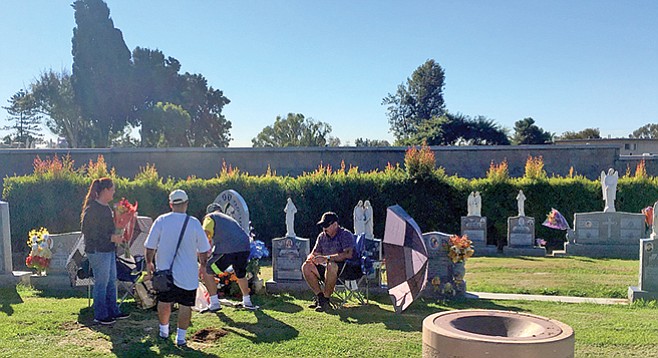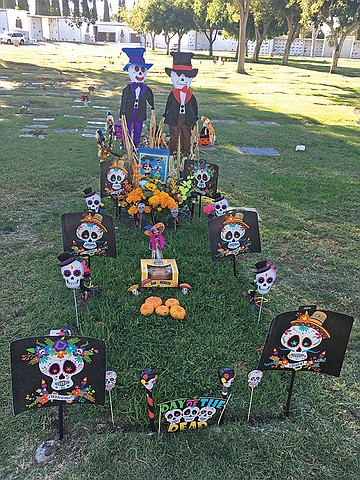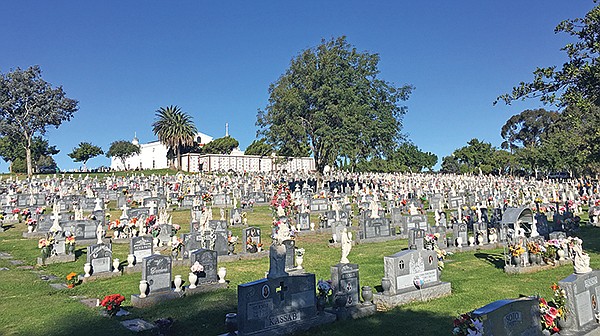 Facebook
Facebook
 X
X
 Instagram
Instagram
 TikTok
TikTok
 Youtube
Youtube

On November 2, the Catholic Church celebrated the Feast of All Souls, commemorating the faithful departed who have died but who have yet to attain beatitude in heaven. The feast reminds the living to pray for dead’s deliverance into paradise, but at Holy Cross cemetery, a number of plots were decorated in a manner reminiscent of the ofrendas traditionally set up on Dia de Muertos to lure them back to earth: Aztec marigolds, storebought loaves of pan de muerto, bony calacas in full dress, even pictures of grinning sugar skulls crying “Welcome!”

Others eschewed Hispanic piety for American spookery, gussying up the graves with traditional reminders of death and decay — skeletons and spiderwebs — and tossing in the odd cartoon witch and jack-o-lantern to boot. Hauling Halloween to a cemetery, a fine modern update of carrying coals to Newcastle. Still others sported more classically pagan accoutrements: five empty bottles of Bud stood atop the headstone of one Alberto Lopez, the popped tops of the libations poured out for the dead resting just off to the side.
Most arresting were the two Mylar balloons — a large red “2” floating above a round “Happy Birthday” — over the grave of Miguel Angel Martinez. A single date was etched into the black stone: November 1, 2016. Elsewhere, families visited their dead; women kneeling with spray bottles, scrubbing dirt from the markers; men standing or sitting still and praying; children wandering unperturbed through the rows of buried bodies. Some brought folding chairs and food, because it’s good for families to spend time together.

Little mysteries: Edward Kuhn’s headstone notes that “We live in hearts that we leave behind.” Kuhn died at 37 in 1941; the stone has space for another name, and appears to have been knocked over and re-mounted at an awkward angle. What happened to the marker, to the family that was left behind, to the person who planned to take that second space? Two separate poems, etched in stone from parents to deceased children, concluded with the line, “God broke our hearts to prove He only takes the best.” Where did this notion come from? How is it a comfort? What does it even mean?
Little revelations: the Stagnaro family stone provided a brief history for passersby. John and Roberta Jean married in 1963 at Our Lady of the Rosary. Four children followed. “Sadly, John, who was a commercial fisherman, was lost at sea with their boat. However, after raising their children and earning her college degrees, Roberta went on to teach at SDSU for 27 years. Although, as in all lives, there were difficult times, the Stagnaros’ blessings far outweighed their challenges…”
Little reminders: there were Virgin Marys everywhere, in statues, in paintings, in mosaics, in carved granite. Also from everywhere: Italy’s pieta, Vietnam’s Lady of La Vang, Mexico’s Lady of Guadalupe, Poland’s Black Madonna, France’s Immaculate Conception, Crete’s Lady of Perpetual Help. Devotions to motherly care brought here from around the world in human hearts, hearts now buried here in our place of common fate.


On November 2, the Catholic Church celebrated the Feast of All Souls, commemorating the faithful departed who have died but who have yet to attain beatitude in heaven. The feast reminds the living to pray for dead’s deliverance into paradise, but at Holy Cross cemetery, a number of plots were decorated in a manner reminiscent of the ofrendas traditionally set up on Dia de Muertos to lure them back to earth: Aztec marigolds, storebought loaves of pan de muerto, bony calacas in full dress, even pictures of grinning sugar skulls crying “Welcome!”

Others eschewed Hispanic piety for American spookery, gussying up the graves with traditional reminders of death and decay — skeletons and spiderwebs — and tossing in the odd cartoon witch and jack-o-lantern to boot. Hauling Halloween to a cemetery, a fine modern update of carrying coals to Newcastle. Still others sported more classically pagan accoutrements: five empty bottles of Bud stood atop the headstone of one Alberto Lopez, the popped tops of the libations poured out for the dead resting just off to the side.
Most arresting were the two Mylar balloons — a large red “2” floating above a round “Happy Birthday” — over the grave of Miguel Angel Martinez. A single date was etched into the black stone: November 1, 2016. Elsewhere, families visited their dead; women kneeling with spray bottles, scrubbing dirt from the markers; men standing or sitting still and praying; children wandering unperturbed through the rows of buried bodies. Some brought folding chairs and food, because it’s good for families to spend time together.

Little mysteries: Edward Kuhn’s headstone notes that “We live in hearts that we leave behind.” Kuhn died at 37 in 1941; the stone has space for another name, and appears to have been knocked over and re-mounted at an awkward angle. What happened to the marker, to the family that was left behind, to the person who planned to take that second space? Two separate poems, etched in stone from parents to deceased children, concluded with the line, “God broke our hearts to prove He only takes the best.” Where did this notion come from? How is it a comfort? What does it even mean?
Little revelations: the Stagnaro family stone provided a brief history for passersby. John and Roberta Jean married in 1963 at Our Lady of the Rosary. Four children followed. “Sadly, John, who was a commercial fisherman, was lost at sea with their boat. However, after raising their children and earning her college degrees, Roberta went on to teach at SDSU for 27 years. Although, as in all lives, there were difficult times, the Stagnaros’ blessings far outweighed their challenges…”
Little reminders: there were Virgin Marys everywhere, in statues, in paintings, in mosaics, in carved granite. Also from everywhere: Italy’s pieta, Vietnam’s Lady of La Vang, Mexico’s Lady of Guadalupe, Poland’s Black Madonna, France’s Immaculate Conception, Crete’s Lady of Perpetual Help. Devotions to motherly care brought here from around the world in human hearts, hearts now buried here in our place of common fate.
Comments